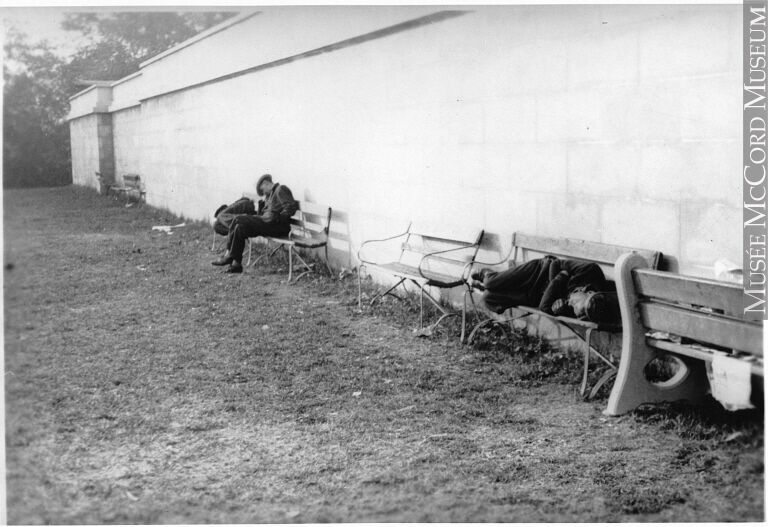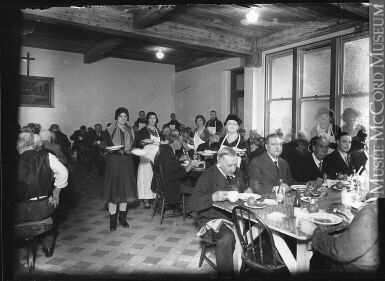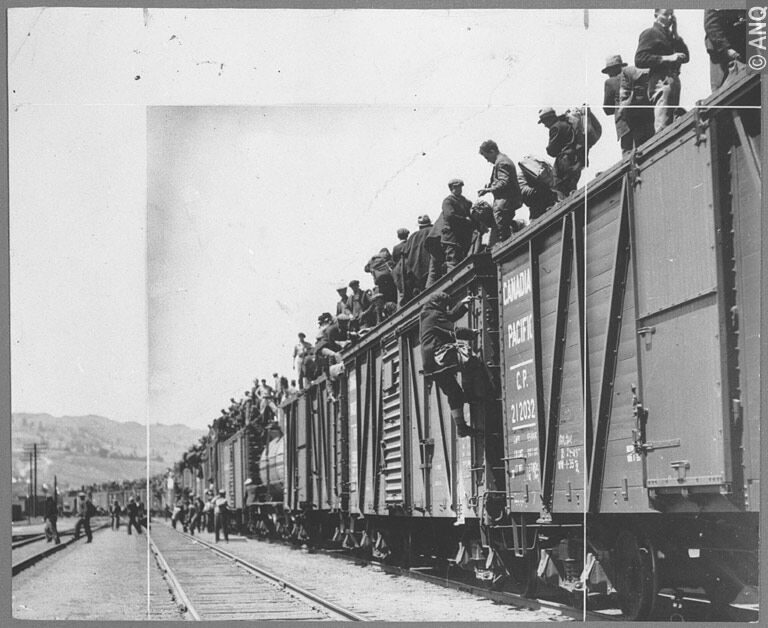The stock market crashed on Thursday, October 24, 1929, a date that was nicknamed “Black Thursday”. This drastic economic decline marked the beginning of the Great Depression. Almost the entire planet felt the repercussions of the crash, causing economic, social and political changes in society.
After being forced to ration and join the war effort during World War I, people just wanted to enjoy themselves. People were spending more money and the standard of living increased very quickly, leading to the Roaring Twenties.
Some people wanted to make more money and decided to invest in the stock market without fully understanding how it worked. People would buy stocks to make more money and the majority would reinvest this money into more stocks. The demand to buy stocks rose rapidly, but the supply stayed the same, causing the value of these stocks to increase. The market value of the shares gradually became much higher than their actual worth.

Many people were trying to make money by buying stocks in the stock market. People were snatching up shares, which drove up the price.
Source: Curb brokers in Wall Street, New York City [Photograph], October 2, 1920, Library of Congress, (URL). *Rights reserved
During the Roaring Twenties, industries were overproducing goods to try to meet consumer demand. When stock owners realized that the various companies were not making as much profit as they thought, they sold their stocks all at once. The value of the stocks fell rapidly because everyone wanted to sell their stocks but there were no buyers.

As the stock market declined, many people withdrew their money from the banks. This led one bank after another to declare bankruptcy.
Source: American Union Bank [Photograph], n.d., Wikimedia Commons, (URL).
The warehouses of several industries continued to fill up with goods. Unable to sell all of their goods, industries started laying off many of their employees. Without a salary, these people lost their purchasing power. Since people lacked the money to buy anything, industries’ sales dropped, companies had to close down or lay off more people, creating a vicious cycle.

The economic crisis cycle led to more unemployed people and fewer job opportunities.

Even though the stock market crash happened in the United States, it had a direct impact on the Canadian economy. Canada’s economy was heavily dependent on trade with its southern neighbour. Due to the crisis, Americans were no longer buying Canadian products, causing the country’s industries to decline like the industries in the United States.
Unemployment rose rapidly in Quebec in the 1930s. Between 1929 and 1932, it went from 7.7% to 26.4%. Between 1929 and 1933, the average per capita income in Quebec decreased by about 44%. Unlike previous economic crises, the situation did not seem to improve.

At the beginning of the crisis, the number of unemployed people increased rapidly and many were left to fend for themselves.
Source: Unemployed men sleeping on park benches, Montreal, QC, circa 1935 [Photograph], Clarke, F. R., circa 1935, McCord Museum, (URL). CC BY-NC-ND
Under these circumstances, the Canadian government and the various provincial governments intervened to try to pull the Canadian economy and society out of the crisis.
Interventionism refers to a policy where the government must intervene in the country’s economic affairs.
Significant amounts of money were being invested by both federal and provincial governments to limit the effects of the crisis.
In 1935, the Bank of Canada was established to stabilize the country’s economy. and centralize control over money.
The increased number of unemployed people living on the streets of major cities created tension in working-class neighbourhoods. Soup kitchens were opened, but this hardly resolved the situation. Religious charity groups that usually helped the poor were overwhelmed.
To prevent riots, the government proposed various solutions, including public works (work camps), colonization, direct relief and assistance to farmers.

Several religious groups and organizations tried to help unemployed people by setting up soup kitchens.
Source: Church basement soup kitchen, Montreal, circa 1930 [Photograph], circa 1930, McCord Museum, (URL). CC BY-NC-ND
This series of measures gave unemployed people various jobs, such as road construction, with salaries paid by the government. Since they were earning a salary, they could buy products and pay for services, thus boosting the economy. In some cases, those who were unemployed were also sent to work camps to keep them out of the cities to avoid riots.

Source: Strikers from unemployment relief camps en route to eastern Canada during "March to Ottawa," June 1935 [Photograph], June 1935, McCord Museum, (URL). CC BY-NC-ND
Unemployed people and their families were also invited to settle in more remote areas. In Quebec, settlers were mainly directed towards Abitibi-Témiscamingue and the Lower St. Lawrence. This measure was proposed by Louis-Alexandre Taschereau’s government. Three colonization plans were implemented throughout Quebec: the Gordon, Vautrin and Auger-Rogers plans. The Church supported the various colonization plans, and saw them as a return to traditional values that encouraged people to leave the cities.

Thanks to the colonization measures, many settlers and their families moved to Abitibi-Témiscamingue and the Lower St. Lawrence.
Source: Un colon débarquant du train avec son chat dans les mains (A settler getting off the train and holding his cat), Laferté [Photograph], Canadian National, 1933, BANQ, (URL).
The Gordon Plan, implemented between 1932 and 1935, was the first provincial and federal settlement program. Under this measure, only unemployed people with access to direct relief and their families received a government subsidy. This money was used to help settlers set up a farm in the area and settle there. However, the colonies were not sufficiently developed. Many roads were impassable, services were lacking and the subsidy was not sufficient. Many settlers ended up returning to the city.
The Vautrin Plan was implemented between 1935 and 1937. This plan was put in place solely by the Quebec government. In addition to giving colonization options to unemployed people, this plan also offered subsidies to farmers’ sons and to bachelors to settle in new regions and was altogether better organized. People moved in groups instead of alone so they could help each other.
Finally, the Auger-Rogers Plan established various measures to help settlers, including more financial assistance. This was a combined agreement between the federal and provincial governments, although municipalities were also encouraged to provide colonization funding. Under this plan, all married men and their families were eligible for the subsidy.
Since some of the new settlers had no farming experience, many abandoned the settlement project and returned to the city. The lack of services and the harsh living conditions in remote areas also discouraged many people from moving out of the cities. However, thanks to support from the mining and forestry companies, many settlers found employment in these new regions.
Direct relief was the predecessor to the current Employment Insurance Program. It was financial aid given to poor families to help them pay for their basic needs. It was often given in the form of coupons that people could exchange for basic necessities such as food or wood for heating.
Commercial agriculture was heavily impacted by the economic crisis because exports ceased. To improve the situation, the Quebec government set up the Office du crédit agricole, providing money to farmers who were struggling financially. With these funds, farmers could produce more goods to try to revive the economy.

Maurice Duplessis’s government established the Office du crédit agricole in 1936.
Source: Maurice Duplessis [Photograph], Fonds J. E. Livernois Ltée, 1938, BANQ, (URL).
Despite all the measures put in place by the various levels of government, the people were still in need. The crisis lasted 10 years and ended when World War II began, creating new jobs for the military and for the military production sector. That said, the economic crisis caused many people to question capitalism as a whole.
Canadian National. (1933). Un colon débarquant du train avec son chat dans les mains (A settler getting off the train and holding his cat), Laferté [Photograph]. BANQ. https://numerique.banq.qc.ca/patrimoine/archives/52327/3223604
Clarke, F. R. (Circa 1935). Unemployed men sleeping on park benches, Montreal, QC, circa 1935 [Photograph]. McCord Museum. http://collections.musee-mccord.qc.ca/fr/collection/artefacts/MP-1988.59.61
Fonds J. E. Livernois Ltée. (1938). Maurice Duplessis [Photograph]. BANQ. https://numerique.banq.qc.ca/patrimoine/details/52327/3114613?docsearchtext=maurice%20duplessis
American union bank [Photograph]. (n.d.). Wikimedia Commons. https://commons.wikimedia.org/wiki/File:American_union_bank.gif
Church basement soup kitchen, Montreal, about 1930 [Photograph]. (Circa 1930). McCord Museum. http://collections.musee-mccord.qc.ca/scripts/viewobject.php?section=162&Lang=1&tourID=CW_Alimentation_EN&seqNumber=24
Curb brokers in Wall Street, New York City [Photograph]. (October 2, 1920). Library of Congress. https://www.loc.gov/pictures/item/92519195/ *Extrait employé par Alloprof conformément à la Loi sur le droit d'auteur dans le cadre d'une utilisation équitable aux fins d’éducation [https://laws-lois.justice.gc.ca/fra/lois/c-42/page-9.html].
Strikers from unemployment relief camps en route to eastern Canada during "March to Ottawa," June 1935 [Photograph]. (June 1935). McCord Museum. http://collections.musee-mccord.qc.ca/fr/collection/artefacts/C-029399/